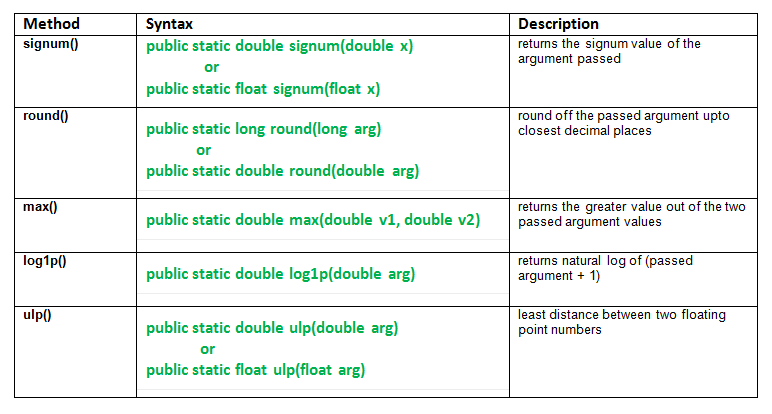Java.math 类及其方法 |设置 1
Math 类提供数学函数来执行基本的数值运算,例如指数、对数、平方根和三角函数。 cosh、sin、tan、abs、bitLength、multiply 等等。 Math 类函数的实现不会返回逐位相同的结果。因此,执行更好的实现。
类声明
public final class Math extends Object这组解释了以下方法: 
方法
- signum() : Java.math.signum()方法返回传递的参数的符号值。
-1 if x < 0 signum fun(x) = 0 if x = 0 1 if x > 0笔记:
- 结果为 NaN,如果传递参数为 NaN。
句法:
public static double signum(double x) or public static float signum(float x) Parameters: x - the argument whose signum value we need Returns: signum value of x - round() : Java.math.round()方法将传递的参数四舍五入到最接近的小数位。
注意:如果参数为 NaN,则结果为 0。
句法:public static long round(long arg) or public static double round(double arg) Parameters: arg - argument needs to round off Returns: round off value of the argument - max() : Java.math.max(double v1, double v2)方法返回两个传递的参数值中较大的值。
该方法仅使用幅度进行比较,不考虑任何符号。
句法:public static double max(double v1, double v2) Parameters: v1 - first value v2 - second value Returns: v1 or v2 based on which number is greater. It can return either of the two if v1 = v2.
Java代码解释了 Math 类中的 signum()、round()、max() 方法。
// Java code explaining the Math Class methods
// signum(), round(), max()
import java.lang.*;
public class NewClass
{
public static void main(String args[])
{
// Use of signum() method
double x = 10.4556, y = -23.34789;
double signm = Math.signum(x);
System.out.println("Signum of 10.45 = " + signm);
signm = Math.signum(y);
System.out.println("Signum of -23.34 = " + signm);
System.out.println("");
// Use of round() method
double r1 = Math.round(x);
System.out.println("Round off 10.4556 = " + r1);
double r2 = Math.round(y);
System.out.println("Round off 23.34789 = " + r2);
System.out.println("");
// Use of max() method on r1 and r2
double m = Math.max(r1, r2);
System.out.println("Max b/w r1 and r2 = " + r2);
}
}
输出:
Signum of 10.45 = 1.0
Signum of -23.34 = -1.0
Round off 10.4556 = 10.0
Round off 23.34789 = -23.0
Max b/w r1 and r2 = -23.0
- log1p() : Java.math.log1p()方法返回(传递的参数 + 1)的自然对数。
句法:public static double log1p(double arg) Parameters: arg - the argument Returns: log of (argument + 1). This result is within 1 unit in the last place of exact result. - ulp() : Java.math.ulp()方法返回最小精度单位(ulp),即。两个浮点数之间的最小距离。
在这里,它是参数和下一个较大值的最小距离 b/w。
句法:public static double ulp(double arg) or public static float ulp(float arg) Parameters: arg - argument passed. Returns: least distance b/w the argument and next larger value.
Java代码解释了 Math 类中的 ulp()、log1p() 方法。
// Java code explaining the Math Class methods
// ulp(), log1p()
import java.lang.*;
public class NewClass
{
public static void main(String args[])
{
// Use of ulp() method
double x = 34.652, y = -23.34789;
double u = Math.ulp(x);
System.out.println("ulp of 34.652 : " + u);
u = Math.ulp(y);
System.out.println("ulp of -23.34789 : " + u);
System.out.println("");
// Use of log() method
double l = 99;
double l1 = Math.log1p(l);
System.out.println("Log of (1 + 99) : " + l1);
l1 = Math.log(100);
System.out.println("Log of 100 : " + l1);
}
}
输出:
ulp of 34.652 : 7.105427357601002E-15
ulp of -23.34789 : 3.552713678800501E-15
Log of (1 + 99) : 4.605170185988092
Log of 100 : 4.605170185988092
- Java.math 类及其方法 |设置 2
- Java.math 类及其方法 |设置 3